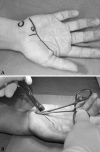Endoscopic carpal tunnel release is preferred over mini-open despite similar outcome: a randomized trial
- PMID: 23100191
- PMCID: PMC3613542
- DOI: 10.1007/s11999-012-2666-z
Endoscopic carpal tunnel release is preferred over mini-open despite similar outcome: a randomized trial
Abstract
Background: The decision to perform endoscopic versus the mini-open carpal tunnel release technique is most likely left to surgeons rather than patients with idiopathic carpal tunnel syndrome.
Questions/purposes: We hypothesized that (1) at 3 months after surgery, the subjective outcomes of endoscopic release, performed on one hand, and mini-incision release, performed on the other, would not differ in patients with bilateral carpal tunnel syndrome; however, (2) each patient would likely prefer one technique over the other for specific reasons.
Methods: Fifty-two patients with bilateral carpal tunnel syndrome had one hand randomized to undergo endoscopic release and the other to undergo mini-incision release. Each patient was assessed with the Boston Carpal Tunnel Questionnaire (BCTQ) and DASH preoperatively and at each followup. Three months after surgery, the patients commented on which technique they preferred and completed a questionnaire regarding the reasons for not preferring the other technique.
Results: The mean BCTQ symptom/function score and DASH improved similarly in the endoscopic release group and the mini-incision release group. Thirty-four patients preferred endoscopic release and 13 preferred the mini-incision technique. Scar or pillar pain was the most commonly cited factor in not preferring either technique followed by postoperative pain for the open technique and transient worsening of symptoms for the endoscopic technique.
Conclusions: Despite similar improvements in BCTQ and DASH scores after endoscopic and open techniques at 3 months postoperatively, the majority of our patients preferred the endoscopic technique. The most concerning reason for not preferring the other technique was scar or pillar pain.
Figures


References
Publication types
MeSH terms
LinkOut - more resources
Full Text Sources
Other Literature Sources
Medical

